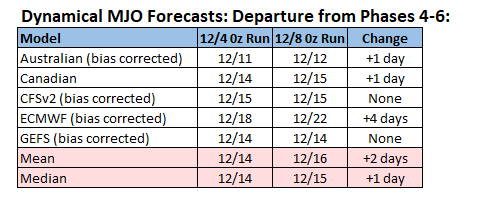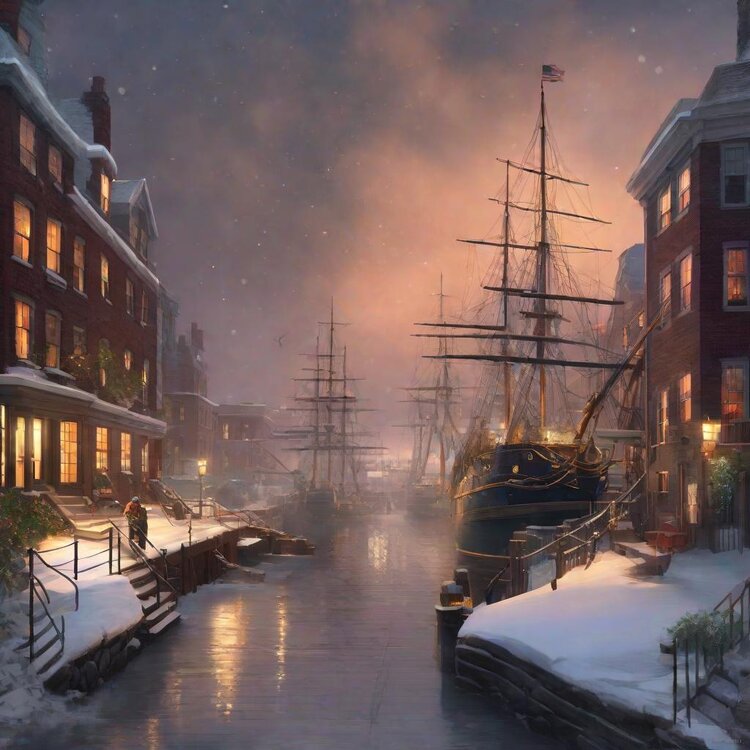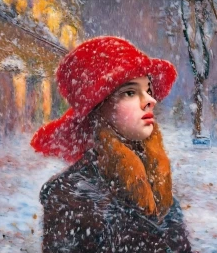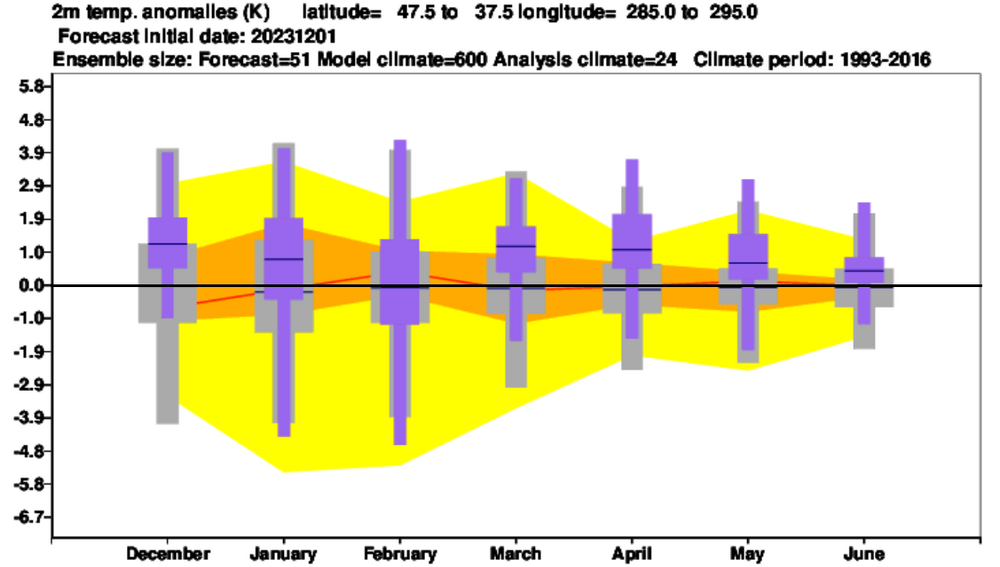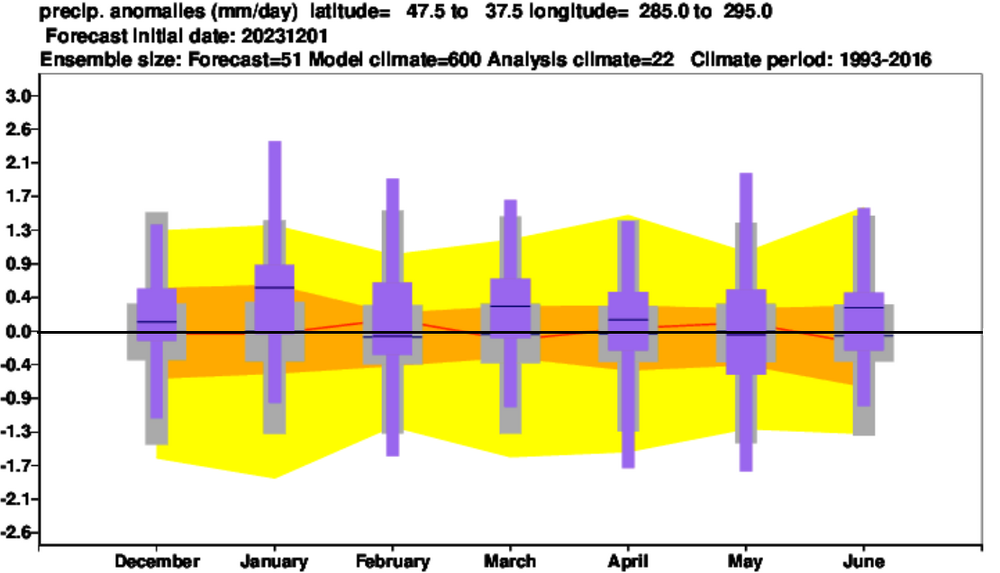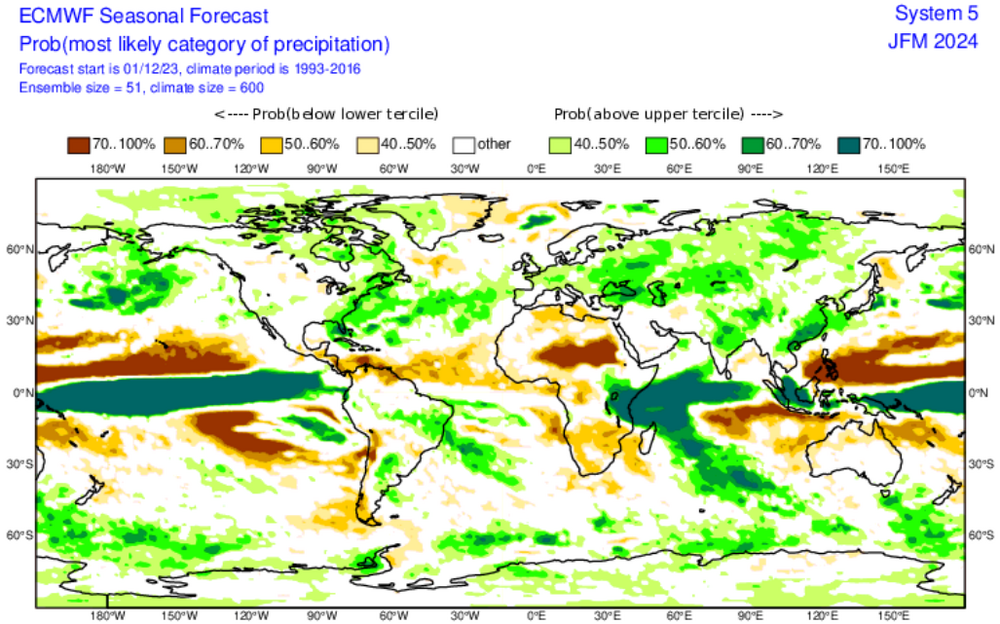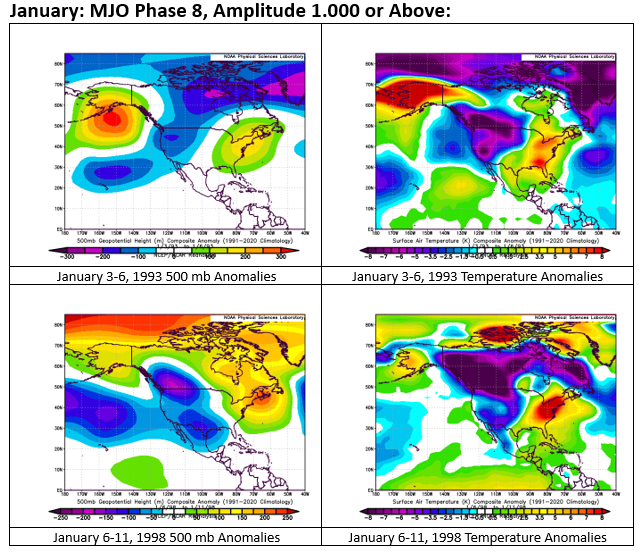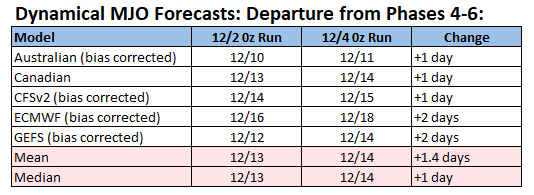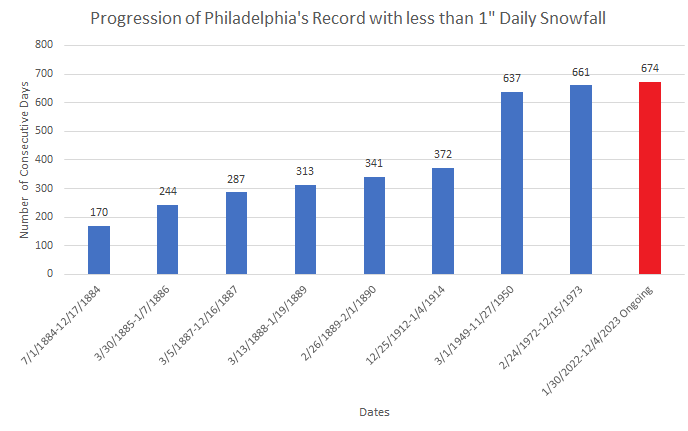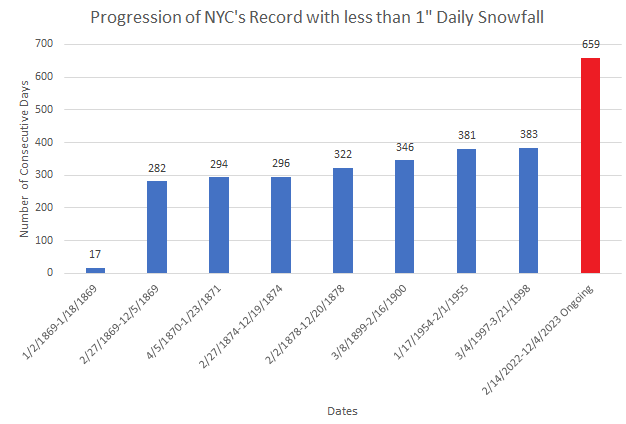-
Posts
22,981 -
Joined
Content Type
Profiles
Blogs
Forums
American Weather
Media Demo
Store
Gallery
Everything posted by donsutherland1
-
The MJO continues to slog through the Marine Continent right now. It still appears likely to exist Phases 4-6 around or just after mid-month. The ECMWF (bias corrected) has a notably slower passage, but it remains an outlier. At the same time, a powerful EPO+ Pacific Trough prevails. The combination of the MJO's progression and the EPO+ suggests that Arctic air will likely be unavailable to be tapped for the foreseeable future. Even as the upcoming weekend storm is followed by a period of cooler but not very cold weather, another warmup lies ahead. It still appears more likely than not that at least some colder air will begin to push into the region in the closing week of December, though the guidance could still be rushing the transition. At least for now, the question seems to concern more the timing of the transition (last week of December vs. first week of January) rather than whether there will be a transition. Of course, skill level at those extended timeframes is low. Fun EPO+ Facts for NYC: Since 1950, there were 6 cases where the EPO reached positive levels at least comparable to the current event for 3 or more days during the first week of December All 6 cases saw the lowest temperature during the December 21-31 period reach at least 22 degrees in NYC One-third of the cases saw one or more days of light measurable snowfall (highest total snowfall: 5.6", 1967) Snowfall after the first week of December for those cases came to the following amounts: 1951-52: 19.7"; 1952-53: 8.4"; 1952-54: 13.6"; 1967-68: 16.3"; 1987-88: 18.0"; 1996-97: 9.9" The biggest snowstorm following the first week of December produced the following amounts: 1951-52: 5.8"; 1952-53; 2.0"; 1953-54: 8.6"; 1967-68: 6.6"; 1987-88: 5.8"; 1996-97: 3.5" 1951-52, 1953-54, and 1987-88 were El Niño winters
-
Distribution of New York City's daily snowfall amounts by ENSO Phase and Month (1949-50 through 2022-23):
-
Winter's two-day visit complete with several bouts of snow flurries and even snow showers is over. Temperatures will begin to rebound on tomorrow with temperatures reaching the middle and upper 40s in much of the region. A very mild weekend will follow. However, a significant rainfall is likely Sunday into Monday. Strong southeasterly winds gusting past 40 mph will impact the region as the strengthening storm passes to the north and west of the region. Coastal flooding and beach erosion are likely. Thunderstorms are possible as the cold front pushes across the region late Sunday or early Monday. The temperature will likely reach or exceed 60° in many locations on Sunday. Overall, the first 10 days of December remain on track to finish with a solidly warmer than normal anomaly. The ENSO Region 1+2 anomaly was +2.1°C and the Region 3.4 anomaly was +2.0°C for the week centered around November 29. For the past six weeks, the ENSO Region 1+2 anomaly has averaged +2.18°C and the ENSO Region 3.4 anomaly has averaged +1.87°C. A basinwide El Niño event is ongoing. El Niño conditions will likely continue to strengthen somewhat further this month. The SOI was -2.02 on December 6. The preliminary Arctic Oscillation (AO) was -2.301 today. Strong blocking in the final week of November, as occurred this year, has often been followed by frequent blocking in December and January. On December 5 the MJO was in Phase 4 at an amplitude of 1.491 (RMM). The December 4-adjusted amplitude was 1.551 (RMM). Based on sensitivity analysis applied to the latest guidance, there is an implied 61% probability that New York City will have a warmer than normal December (1991-2020 normal). December will likely finish with a mean temperature near 40.4° (1.3° above normal).
-
NYC actually fell to -1° on Valentine's Day 2016.
-
I raised a scenario where the PV could get stronger, but my thinking is that such a scenario is not on the table this winter. If I had to venture a guess, the odds of such a scenario playing out are probably less than 20%. I expect a generally weak SPV to persist through much of the winter.
-
The 5-10 or 6-10 day period could see cool readings. Tropical Tidbits is still using the old 1981-2020 base period, which understates the cold and overstates the warmth relative to the warmer 1991-2020 baseline that is now in use. The warmth rebounds for a time (check out days 10-15). It's not extreme warmth, but readings wind up in the middle and perhaps upper 40s (45 is the end value for Central Park) by the end of the 0z EPS run in the NYC area. The latest CFSv2 weeklies keep the warm anomalies going through the end of the month. The ECMWF weeklies continue to show a pattern evolution. If past years are representative, the change to a more favorable pattern might take somewhat longer than currently modeled. It seems that the weekly guidance has two big issues beyond two weeks: either a bias for continuity that frequently runs through weeks 5-6 or, when it breaks from continuity, the rushing of pattern changes. I still think January and February will offer opportunities for cold and snow. The last week of December could see cold start to return, but I wouldn't be too surprised if it takes until the first week in January. There has been notable warming of the stratosphere, focused on 5 mb to 10 mb. However, there's still no forecast for the kind of wind reversal that defines major warming events through 10 days (ECMWF ensemble mean). For now, the stratospheric vortex still looks to remain weak through the foreseeable future, which should afford higher blocking possibilities. There is a risk that once the stratosphere cools, especially if there is no zonal wind reversal, that could allow the stratospheric polar vortex to strengthen. There's no guidance showing such an outcome, but it has happened in some past winters. Such a development would cause problems for January and perhaps beyond. I'm articulating this risk, but I don't think it is the most likely outcome right now. Finally,there has been some chatter about extreme cold (e.g., single-digit-type cold for NYC) to end December/start January. I'm very skeptical of such calls. Numerous El Niño winters, even snowy ones, have not seen single-digit or colder peak cold in NYC.
-
I would be surprised if we don't see some snow flurries in the City. A somewhat heavier snow shower is possible, though most of those will probably occur outside of the City.
-
I created it with a prompt (18th century harbor scene following a snowstorm) using the DaVinci AI.
-
Phoenix had both its hottest summer and hottest fall. Phoenix added a record high today to its collection of record highs this year. Miami is all but certain to record its warmest year on record. 2019, 2020, 2021, 2022, and 2023 will all rank among its 10 warmest years on record. Miami's full-year records go back to 1896.
-
Tomorrow should be another cool, but not very cold, day. Some snow flurries and snow showers are again possible. Temperatures will begin to rebound on Friday with a very mild weekend following. A moderate to significant rainfall is likely Sunday into Monday. Strong southeasterly winds could impact the region as the strengthening storm passes to the north and west of the region. Coastal flooding and beach erosion are likely. Overall, the first 10 days of December remain on track to finish with a solidly warmer than normal anomaly. The ENSO Region 1+2 anomaly was +2.1°C and the Region 3.4 anomaly was +2.0°C for the week centered around November 29. For the past six weeks, the ENSO Region 1+2 anomaly has averaged +2.18°C and the ENSO Region 3.4 anomaly has averaged +1.87°C. A basinwide El Niño event is ongoing. El Niño conditions will likely continue to strengthen somewhat further this month. The SOI was -2.02 today. The preliminary Arctic Oscillation (AO) was -2.427 today. Strong blocking in the final week of November, as occurred this year, has often been followed by frequent blocking in December and January. On December 4 the MJO was in Phase 4 at an amplitude of 1.551 (RMM). The December 3-adjusted amplitude was 1.323 (RMM).
-
That’s an earlier version AI. The images are even better (but not yet comparable to top humans) on the more advanced tools. Here’s one from another AI:
-
I can understand. It’s a terrible experience that one often does not forget.
-
The worst of the winds will probably be after 9-10 pm.
-
At this time, the worst of the storm appears likely to occur during the night. However, there could still be some changes in the timing.
-
Unfortunately, this: Not this: Nevertheless, it should be a wild event. 1"-2" of rain will be likely (likely washing away my idea that 2023 would fall just short of 55" annual precipitation in NYC), with 40 mph+ gusts, coastal flooding and beach erosion. The temperature could spike to 60° or above. Tree damage is possible and some power lines could be brought down. Note: All images were AI-generated.
-
Tomorrow through Thursday should be cool, but not very cold, days. Temperatures will begin to rebound on Friday with a very mild weekend following. A moderate to significant rainfall is likely Sunday into Monday. Strong southeasterly winds could impact the region as the strengthening storm passes to the north and west of the region. Overall, the first 10 days of December remain on track to finish with a solidly warmer than normal anomaly. The ENSO Region 1+2 anomaly was +2.1°C and the Region 3.4 anomaly was +2.0°C for the week centered around November 29. For the past six weeks, the ENSO Region 1+2 anomaly has averaged +2.18°C and the ENSO Region 3.4 anomaly has averaged +1.87°C. A basinwide El Niño event is ongoing. El Niño conditions will likely continue to strengthen somewhat further this month. The SOI was -6.85 on December 4. The preliminary Arctic Oscillation (AO) was -2.817 today. Strong blocking in the final week of November, as occurred this year, has often been followed by frequent blocking in December and January. On December 3 the MJO was in Phase 4 at an amplitude of 1.409 (RMM). The December 2-adjusted amplitude was 1.402 (RMM).
-
For those who are interested, below are the ECMWF monthly temperature and precipitation forecasts for the Northeast (I added the black line to demarcate the "normal" figure on the charts). The purple is the model forecast:
-
-
Cooler air will continue to overspread the region overnight. Most of the remainder of the week should be cooler than normal, but not very cold. Temperatures will likely rebound during the weekend. Overall, the first 10 days of December remain on track to finish with a solidly warmer than normal anomaly. A moderate to significant rainstorm is also possible during the weekend, possibly Sunday. The ENSO Region 1+2 anomaly was +2.1°C and the Region 3.4 anomaly was +2.0°C for the week centered around November 29. For the past six weeks, the ENSO Region 1+2 anomaly has averaged +2.18°C and the ENSO Region 3.4 anomaly has averaged +1.87°C. A basinwide El Niño event is ongoing. El Niño conditions will likely continue to strengthen somewhat further this month. The SOI was not available today. The preliminary Arctic Oscillation (AO) was -3.032 today. Strong blocking in the final week of November, as occurred this year, has often been followed by frequent blocking in December and January. On December 2 the MJO was in Phase 4 at an amplitude of 1.402 (RMM). The December 1-adjusted amplitude was 1.269 (RMM).
-
Although winter 2022-2023 very likely won't resemble something like 2009-10, it could feature a few shots at snowfall. If everything goes well, we might see an El Niño winter that has one really big storm as happened during the strong ENSO events during 1982-83 and 2015-16.
-
I agree. Most December and January cases following the kind of deep blocking that developed in the last week of November have seen frequent blocking. Many February cases have, too.
-
Not necessarily. If we can more or less keep the blocking, there will be some opportunities (mostly January and perhaps February). Also, those are exceptional cases. They aren't the norm.
-
The MJO has a meaningful influence on patterns, but its impact can be muted or overwhelmed by other variables. Two examples include January 1993 and January 1998. Both months wound up much warmer than normal, despite the MJO's passing through Phases 8-1-2 for 13 days in 1993 and 10 days in 1998. Here's how those two cases fared when the MJO was in Phase 8 at a high amplitude in January.
-
While I wouldn't rule out a 2001-type outcome were the blocking to break down during the 12/18-25 period, I don't see anything that suggests a 2015-type scenario. December 2015 had no freezes (we could see one this week). December 2015 also had 11 days with lows of 50° or above and 11 days with highs of 60° or above at Central Park.
-
The latest MJO forecasts show a slightly longer passage through Phases 4-6 than had been shown two days earlier (Bluewave has discussed the role of sea surface temperature anomalies in foreshadowing such an outcome): The Week 3 CFSv2 (12/18-24) and ECMWF (12/18-25) are very warm in the East (>3°C/5.4°F above normal). Were blocking to break down, the possibility of one or more days in the 60s in the region (maybe even 70° in the Baltimore-Washington area) during that timeframe would increase markedly. Beyond Week 3, the ECMWF weeklies still show cooler than normal readings in the East to start January. However, skill levels beyond two weeks are low. The latest ENSO data shows that a basinwide strong El Niño event continues. The latest ENSO Region 1+2 anomaly was +2.1°C. The latest ENSO Region 3.4 anomaly was +2.0°C. The AAM is poised to go positive in coming days and then strongly positive through at least late December. A positive AAM often indicates patterns consistent with El Niño events. El Niño cases favor warm Decembers in the East, though there are exceptions. With winter largely sleeping through the medium-term, New York City's and Philadelphia's record streaks without their having seen 1" or more daily snowfall will continue for the foreseeable future. New York City's ongoing streak will very likely surpass the existing record streaks at Newark (661 days) and Trenton (664 days). Things could be worse from a winter lover's perspective. This most definitely is not December 2015 where New York City experienced a monthly mean temperature of 50.8°, decimating the record of 44.1° that had been set in 2001. Finally, Miami hit 89° yesterday, which tied its December monthly record. Miami is all but certain to record its warmest year on record. In fact, 2019, 2020, 2021, 2022, and 2023 will all rank among its 10 warmest years on record.



